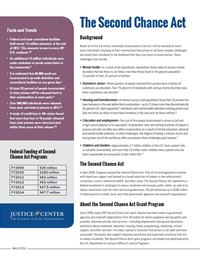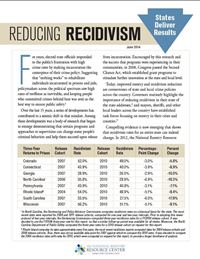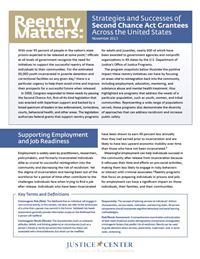Prisoners don’t have to return to a life of criminal behavior once they’re released. Reentry programs can help them become productive members of society instead. That’s why Congress passed the 2007 Second Chance Act to fund programs including substance abuse treatment and job training for ex-cons.
Prominent studies show that reentry programs reduce crime and save taxpayers money. This bill deserves to be renewed. But Congress must re-authorize the Second Chance Act in 2014 or it will expire.
- The Second Chance Act reduces costs and saves taxpayer dollars. With corrections cost exceeding $60 billion a year, state and local governments have redirected their focus on making sure that newly released prisoners stay out of jail instead of coming back.
- We are seeing reductions in recidivism rates all across the nation. In Illinois, the recidivism rate declined by 10 percent, from 52.3 percent for those released in 2005 to 47 percent for 2008 releases; in Texas, the decline between 2005 and 2009 releases was 17 percent. Ohio recently announced that recidivism in the state is now at 27 percent, its lowest rate in many years. Kansas, Michigan, Mississippi, Oregon, and Vermont are among other states that have seen reductions in recidivism in the past decade.
- As interest in reentry programming expands, the body of knowledge around what works to reduce recidivism and improve other outcomes has grown and is able to inform further reentry initiatives. Inmates need help addressing the addictions, mental illnesses and problems that sent them to prison. Otherwise, statistics say they’re likely to commit another crime, hurt someone, damage property and be a further drain on the community. Thanks to the Second Chance Act, more inmates have had access to education and crime has been reduced. Criminal Justice experts say the education, drug treatment and training programs have helped to create safer communities.
- Over 1.5 million people are currently in state or federal prisons; of the state prisoners, it is estimated that 95 percent will be released at some point.
- We are seeing a large return on our investment. For every $1 spent on Second Chance Act reentry programs, we are seeing returns ranging from $11.05 to $40.76.
You can help, just by speaking up! Make your voice heard, especially if you work in the district of a key member of Congress, in CA, LA, OH, SC, TX, UT, VA, or WA (See details.)
- Now 600 groups have signed their name to an open letter endorsing the Second Chance Act re-authorization. Will you support us? Email johnny@centerforprisonreform.org and confirm we can add your group’s name to the list.
- Write to ask your Senator and member of Congress to cosign the re-authorization, using the map at the bottom of this page.
- If your House representative is a member of the House Judicary Committee, ask him or her to cosign the open letter from Representative Jim Sensenbrenner to Representative Bob Goodlatte, Chairman of the House Judiciary Committee.
Of course, we’d also love to have you participate in the Center for Prison Reform coalition and newsletter!
Please email us at johnny@centerforprisonreform.org with your questions and comments.
Contact your Representatives in Congress!




